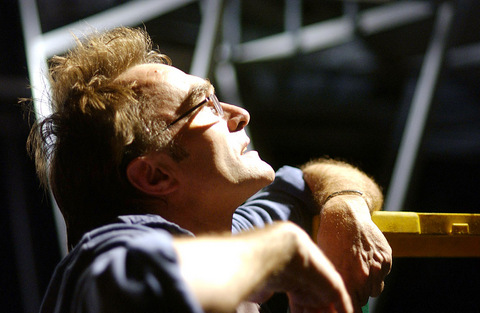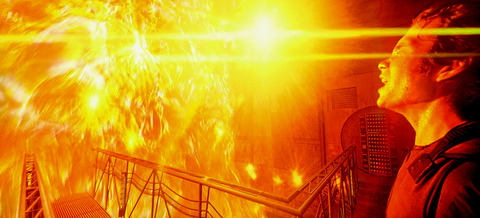At a key moment in Danny Boyle's radiant new sci-fi film Sunshine, a character is asked, "Are you an angel?" With its retina-scorching visuals, which blaze from the screen into the dark abyss of the cinema auditorium, this extraordinary epic certainly seems to burn as brightly as a host of fiery angels. Set in 2057, Sunshine follows the crew of the spaceship Icarus II as they attempt to deliver a thermonuclear payload into the heart of the sun, lending new light to our galaxy's inexorably darkening star. En route, they pick up a distress signal from their lost predecessor, Icarus I, which disappeared into the void seven years earlier. Like an interstellar Marie Celeste, the first Icarus now hangs in space like a ghost ship, seemingly without a soul in sight. But as the reason for its mission failure is gradually revealed (more psychological than scientific), the crew of Icarus II fall prey to the eternal inner demons which haunt those who fly too close to the sun.
Shot not in Hollywood but in the 3 Mills studios in London's East End, Sunshine boasts extraordinary computer graphic imagery so luminescent you feel you could get sunburn just watching the film. As a sensory experience, it's overwhelming. But perhaps more importantly, Sunshine also harks back to a time when sci-fi turned its attention not toward the hallowed teen market but toward the heavens. Although screenwriter Alex Garland has said the inspiration for the film came from "an article projecting the future of mankind from a physics-based, atheist perspective," this ambitious British fantasy increasingly blurs the boundaries between science and religion. In this respect, it falls within a grand tradition of adult-orientated science-fiction, which is haunted by the question of divinity, whether as a presence or an absence.
These ideas are familiar to director Danny Boyle, who had a traditional religious upbringing, and planned to join a seminary at the age of 14. "I was at school in Bolton," he remembers, "and all set to transfer to this seminary near Wigan. Then one of the priests told me that maybe I should wait, maybe I should stay and finish my school education. Quite soon after that, I saw A Clockwork Orange, which was the first film I went to see by myself. And it just changed everything. I know it all sounds too neat, but that's what happened."

PHOTOS COURTESY OF FOX
Boyle went on to make Trainspotting, which has been dubbed "the Clockwork Orange of the Nineties" — a viscerally hip portrait of anarchic youth culture which became both a controversial modern film classic and a defining pop icon. Yet despite his current free-form agnosticism, Boyle's films have continued to be haunted by the detritus of his religious background, from the worldly angels of the romantic fantasy A Life Less Ordinary (which owes a debt to Powell and Pressburger's A Matter of Life and Death aka Stairway to Heaven) to the solidly earthy apparitions of saints who appear to the young hero of the underrated Millions. Other Boyle hits include 28 Days Later, a Garland-scripted zombie shocker set in a terrifying post-apocalyptic Britain. Now, with Sunshine, Boyle has set his sights higher than ever before, making a film which addresses "what happens to your mind when you meet the creator of all things in the universe."
Sci-fi fans will see a range of familiar texts echoed in the broadstrokes outline of Sunshine, most notably Paul Anderson's Event Horizon, a flawed but fascinating 1990s Brit-pic in which a lost spaceship re-emerges from a black hole having been to hell and back — literally.
The primary heavenly body around which Sunshine charts its orbit is Kubrick's 2001: A Space Odyssey, a weighty and portentous work which opens with The Dawn of Man and climaxes with the birth of a Star Child in what appears to be an extraterrestrial rewriting of the creationist myth. Just as God creates Adam in his own image in Genesis, so the "aliens" of 2001 transform a dying astronaut into a perfectly formed space baby, the first of a new species which will return to earth (presumably) to herald the next age in man's cosmic evolution.

This conclusion may be obliquely expressed (I remember thinking "what was all that about?" and having to read the novel to find out) but the mesmerizing symphony of sound and vision which constitutes the film's final act clearly suggest a metaphysical encounter way beyond the realms of rational explanation. Dubbed "the ultimate trip," Kubrick's psychedelic movie used music by the avant garde composer Gyorgy Ligeti, which Underworld's Karl Hyde admits profoundly influenced his own work on the music for Boyle's new film. "I'd never heard anything like it," says Hyde of Ligeti's Lux Aeterna, which sounds for all the world like choirs of alien angels ringing throughout the heavens, investing 2001's baffling denouement with undeniable overtones of religious ecstasy and unearthly transcendence.
There's a strikingly similar blend of science and theology in Sunshine, in which whiz-kid physicist Capa (played by the ethereally blue-eyed Cillian Murphy) comes face to face with his maker in the shape of a dying sun. Just as the enigmatic monoliths from 2001 act as creative gods to the earthlings, so the sun serves as both the giver of life and the source of all knowledge in Boyle's soul-searching movie.
"I tried to keep it visual," says Boyle, "because some of the ideas in the film are very hard to talk about. But when we were making Sunshine, which involved a lot of post-production special effects, my responsibility to the actors was to describe to them what they would be seeing. I was brought up in a religious environment, and so my natural tendency was to lapse into descriptions which were broadly creationist. I'd be saying things like: 'Kneel before the source of all creation, bow down before the source of all life!' And even Alex [Garland], who is quite an aggressive atheist, has that same cultural instinct in the language that he uses."

So too, it appears, does Sunshine's scientific consultant Brian Cox, who works at Cern (the Center for European Nuclear Research), the world's largest particle-physics laboratory. According to Boyle, Cox's work includes the pursuit of the Higgs boson, the missing piece in the current theory of the fundamental nature of matter, which is affectionately known amongst scientists as the "God particle." "Brian Cox admits that you can't really speak about these things without allowing for what some people would call a 'spiritual dimension,'" says Boyle. "The question is, of course, whether that spiritual dimension is just a constraint of the language — the fact that we simply have no other vocabulary to describe such things. I think that's what Alex believes. But for me, what Capa sees at the end of the movie is definitely something beyond the rational."
The theosophical tendencies of the genre were not quelled by the kidtastic assault of George Lucas and his clones. Although Star Wars and its spin-off sequels and prequels played primarily to a congregation of children and arrested adolescents, the endless ooga-booga about The Force and The Dark Side have since flourished into something resembling a modern religion that commands an army of merchandise-hungry disciples. I can't stand the Star Wars movies, which always seemed to me to represent a gross infantalization of the dark hearted "serious" sci-fi (Quatermass, Silent Running, Soylent Green) on which I was raised. But I've heard pulpit preachers quote Yoda in their attempts to engage young people with religion, the battle between Good and Evil having been played out in the popular imagination as a war between Sith Lords and Jedi Knights.
Even Captain Kirk has dabbled in the search for God, most egregiously in Star Trek V: The Final Frontier in which the Enterprise boldly goes "through the barrier" between this world and the next. One sub-2001 light show later, and Kirk is splitting infinitives in heaven. Of course, it all turns out to be a con, but not before everyone has had a chance to pontificate at great length about the meaning of paradise and the nature of the divine being. (The film was directed by William Shatner himself, which perhaps explains why God turns out to be no match for Captain Kirk.)

Danny Boyle sensibly prefers Robert Zemeckis's 1997 film Contact, large swathes of which involve heated debate about whether a priest, a psychoanalyst or a particle physicist would be best placed to represent mankind in our first meeting with extraterrestrial life-forms. "I was there on opening night," says Boyle, a devoted sci-fi fan with an enthusiasm for the genre in all its forms.
Having completed Sunshine, however, this endlessly energetic filmmaker has no plans to revisit sci-fi, which has a habit of producing creative burnout. "There's a reason why many directors only make one science-fiction film," he says.
"It's because you exhaust yourself ... spiritually. I do think that I've become more spiritual working on this — you have to be open-minded. The interesting thing is that the more commercial sci-fi films, like Event Horizon or Alien, tend to go for Hell in space. But maybe its more ambitious to aim for Heaven."


In the March 9 edition of the Taipei Times a piece by Ninon Godefroy ran with the headine “The quiet, gentle rhythm of Taiwan.” It started with the line “Taiwan is a small, humble place. There is no Eiffel Tower, no pyramids — no singular attraction that draws the world’s attention.” I laughed out loud at that. This was out of no disrespect for the author or the piece, which made some interesting analogies and good points about how both Din Tai Fung’s and Taiwan Semiconductor Manufacturing Co’s (TSMC, 台積電) meticulous attention to detail and quality are not quite up to

April 21 to April 27 Hsieh Er’s (謝娥) political fortunes were rising fast after she got out of jail and joined the Chinese Nationalist Party (KMT) in December 1945. Not only did she hold key positions in various committees, she was elected the only woman on the Taipei City Council and headed to Nanjing in 1946 as the sole Taiwanese female representative to the National Constituent Assembly. With the support of first lady Soong May-ling (宋美齡), she started the Taipei Women’s Association and Taiwan Provincial Women’s Association, where she

It is one of the more remarkable facts of Taiwan history that it was never occupied or claimed by any of the numerous kingdoms of southern China — Han or otherwise — that lay just across the water from it. None of their brilliant ministers ever discovered that Taiwan was a “core interest” of the state whose annexation was “inevitable.” As Paul Kua notes in an excellent monograph laying out how the Portuguese gave Taiwan the name “Formosa,” the first Europeans to express an interest in occupying Taiwan were the Spanish. Tonio Andrade in his seminal work, How Taiwan Became Chinese,

Mongolian influencer Anudari Daarya looks effortlessly glamorous and carefree in her social media posts — but the classically trained pianist’s road to acceptance as a transgender artist has been anything but easy. She is one of a growing number of Mongolian LGBTQ youth challenging stereotypes and fighting for acceptance through media representation in the socially conservative country. LGBTQ Mongolians often hide their identities from their employers and colleagues for fear of discrimination, with a survey by the non-profit LGBT Centre Mongolia showing that only 20 percent of people felt comfortable coming out at work. Daarya, 25, said she has faced discrimination since she